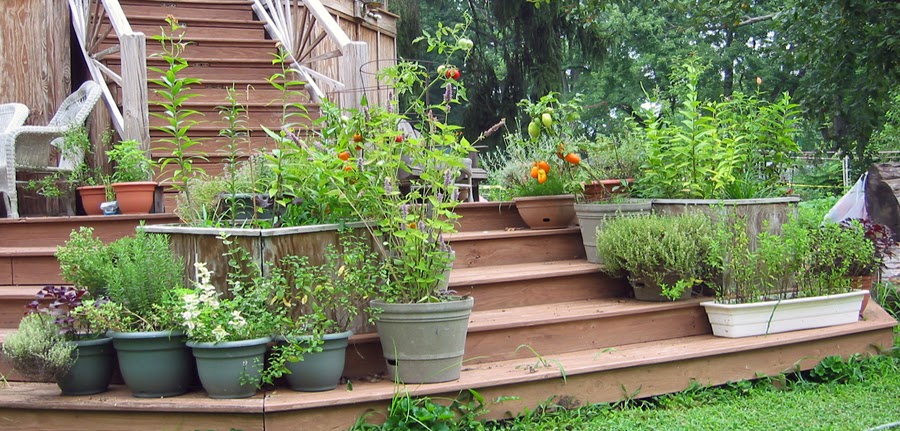Beautify your yard with organic gardening
 |
| A garden created by Prior Unity Garden. |
By Marie Reinsdorf
If you are not yet growing some of your own food in your backyard, you can do it—and in such a way that your food plants are part of beautiful landscaping.
Debby Ward offered lots of advice on how to do that in a presentation on backyard organic gardening and “foodscaping” at a Green Breakfast March 8 at Brion’s Grille in Fairfax. Ward runs a food-growing design, installation, and consulting/training business for homeowners called Prior Unity Garden. Her business’s slogan is “Growing Your Own Organic Food Made Easy,” and she speaks frequently on that topic.
Green Breakfasts are bimonthly informal gatherings open to the public with speakers on various environmental issues organized by the Northern Virginia Soil and Water Conservation District. If you’re interested in attending these events, call the NVSWCD, 703-324-1460, to be added to the email list
 |
| A container garden by Prior Unity Garden. |
Ward advises home gardeners to use permaculture practices, which put the resources of your property and garden to work for you. An example is planting a fruit tree as part of a “fruit tree guild,” where the tree is surrounded by beautiful plants that benefit the tree.
If you have a slope, the digging of low swales can capture rain water and allow it to seep slowly into the ground. As the plants immediately below use their roots to drink up that water, there will be less runoff from your property and less need for you to water your plants.
Permaculture design, with its 12 principles—“use and value renewable resources and services” is one—will give you an endlessly fascinating way to study and work with your property’s natural environment and build in foodscaping that takes advantage of it.
Another idea is creating a “mini-food forest.” This can consist of an oak tree, for example, with a couple of hazelnut trees beneath it, native blueberry bushes nearby, with alpine strawberry for groundcover and perhaps some wintergreen, too, from which you can make wintergreen tea.
If you’re planning a garden in the sun, there are many planting combinations of vegetables, herbs, and flowers that have companion benefits, as well as beauty. Plant nasturtiums near your squash and cucumbers. Nasturtiums are lovely, with edible flowers and leaves. They also repel squash borers and trap aphids. It’s hard to think of a better friend than the nasturtium.
Ward also loves to talk about good soil, and her designs incorporate soil building. The paths between her food garden beds are made into little “soil factories,” laid with cardboard, leaves, and clippings, among other things. “Whenever someone says to me that they can’t grow anything and have a brown thumb, I say, wonderful! Your brown thumb will grow soil, and the soil will then grow your plants for you,” Ward says.
Don’t let insufficient sunlight deter you. Container gardens are a great way to build a food garden if you don’t have a usable yard. In partial shade, you can grow lettuces and brassicas, which include cabbage, broccoli, and kale.
There are many more benefits to gardening than a plentiful harvest. Gardening side by side with your child or grandchild, or with neighbors in a community garden, for example, builds and strengthens bonds to others.
To learn more, come to an upcoming event co-sponsored by Prior Unity Garden and organized by local volunteers interested in promoting healthy self-sufficiency in eating.
Grow Your Health takes place Sunday, March 23, 11 a.m.-5:30 p.m., at Woodson High School. There will be sessions on starting your first garden, gardening with kids, small-space gardening, gardening in shade, managing bugs and pests without chemicals, and other topics. Admission is $10 for adults (free for children under 16) with advance registration.
Spring is around the corner. Learn some new gardening techniques and kick-start your own food-growing plan.

